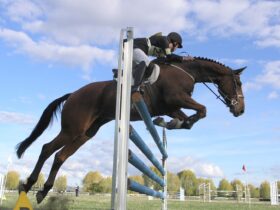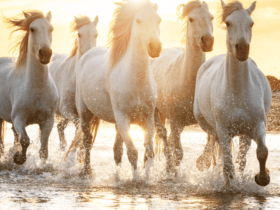The 4-1-1 on Fascia from Equine Bodywork Practitioner Margret Henkels
—Extract from Is Your Horse 100%? by Margret Henkels
Conformation is not only the horse’s inborn natural ability and structural appearance, it is also his ability and structure in real time. Conformation structure includes how the horse stands, how efficiently he uses his body, and whether all the parts are functioning completely. The horse’s entire being is included in conformation.
When a horse is born genetically well balanced and capable, yet loses his ability by three years of age, he is no longer perceived by us, or himself, as a fit and capable horse. The athletic gifts of good conformation become lost to him and us. He knows he should be able to do his work, but he can’t. He’s confused by this loss of ability. There may be little or no active pain, yet he can’t move well.
This lack of fitness then brings him anxiety and defensiveness: insecurity is extremely dangerous for a prey animal, which is why imbalance and cellular memory of injury causes so much difficulty for him. We humans are the same (although we’re at the top of the food chain these days). We all know of a rider who has “lost her nerve” after an accident, or perhaps it’s an athlete who has the ability yet cannot access her gifts fully. This is the result of the body’s cellular memory, or Soma-Emotional Recall, which we have defined as trauma held in the fascial tissue (the gossamer white tissue in the body that connects all the horse’s body’s parts, including bones, muscles, and all the different body systems). While science often ignores emotional energy as unimportant, it is indeed a factor in fascial health.

A horse’s conformation is affected by the state of his fascia. As areas of strain or injury progress, whole sections of his body lose their shape and function. Shoulders have a “hollow” look. Hips lose their muscle. The neck almost wastes away due to the compression of tight fascia. This overall slow compression due to a single-strain event progresses eventually to a place where the horse “just can’t do that anymore.” A left lead at the canter can’t happen. Or, collection goes from being “difficult” to do, to work we don’t attempt. A once-fit horse becomes consistently lame. A balanced, fit horse can competently move through extreme stresses such as jumping or racing, but a horse with fascial “compensations” cannot even stand square. Worst of all, the adhesions continue to tighten, creating even more compensation patterns. He has no way to be comfortable again. Drugs may dull the pain, but they won’t restore movement.
This slow but progressive loss of fascial balance throughout the horse’s body seems to appear suddenly. One day, we realize our horse doesn’t look good. He’s unable to easily stand square, his shoulders and hind end aren’t muscled well, and his back dips. He’s hard to tack up because he hurts. Correct lead changes are impossible. We don’t canter anymore. He is inconsistent in his performance. Finally, the horse is cranky and irritable. We are not having much fun together. Is a new horse the answer, we ask ourselves? If we love or even like our horse, we tend to accept the limits and learn to do less with him. The cycle of looking for “fixes” begins.
There’s a solution to this loss of fitness. Just as we know people who have recovered full fitness from all kinds of accidents, the horse can recover, too. Learning to work with the fascia to release strain and imbalance—something every horse owner can do safely—leads to dramatic improvements when we follow the visual clues and learn to look carefully at our horse’s shape and stance. We look past good breeding and pleasant features as our eyes learn to see, and as our hands feel his body, we find areas of hardness, stiffness, and pain. These are the blockages to easy movement and full muscle development. The visual signs of a “used-up horse” are nearly always temporary problems.
This excerpt from Is Your Horse 100%? by Margret Henkels is reprinted with permission from Trafalgar Square Books (www.horseandriderbooks.com).
HorseandRiderBooks.com is the storefront for Trafalgar Square Books of North Pomfret, Vermont—a small, privately-owned publisher of fine equestrian books, eBooks, and videos, craft books, and selected other titles.























SOCIAL